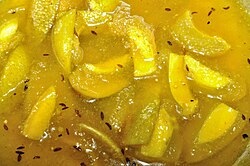 Mango chutney with cumin seeds | |
| Type | Chutney |
|---|---|
| Course | Dessert |
| Region or state | South Asia |
| Serving temperature | Hot |
| Main ingredients | Raw mango |
| This article is part of the series on |
| Indian cuisine |
|---|
 |
 |
| This article is part of the series |
| Pakistani cuisine پاکستانی پکوان |
|---|
Green mango chutney, [1] also known as raw mango chutney, is an Indian chutney prepared from unripe mangoes. [2] [3] Ripe mangoes are sweet and are not used for chutneys as they are eaten raw. Green unripe mangoes are hard and sour, and they are cooked as chutneys. Mango chutneys are tangy in taste.